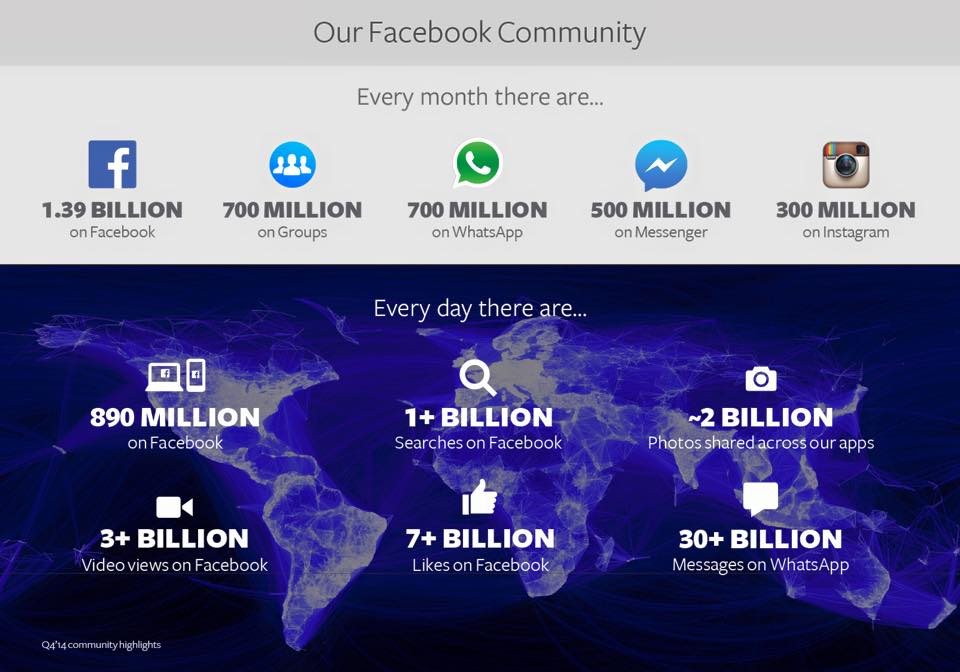Skift Take
Zuckerberg and his team hope to further connect the dots between the activity on social, online, and real-life by holding the proverbial social-ROI carrot over marketers' heads.
What do travel marketers need to know about Facebook’s operations in 2014 and what the social network is focusing on in 2015?
One of the things that clearly emerged from Facebook’s fourth quarter and full-year 2014 earnings call with analysts last week is that being social is no longer enough, and that Facebook is investing in advertising technology, mobile, and video to make marketing through Facebook more effective for partners and to increase its own monetization.
Coming just a few weeks before Facebook’s 11th birthday, CEO Mark Zuckerberg and COO Sheryl Sandberg talked about these investments and it became apparent that Facebook’s audience growth is plateauing — excluding Instagram and WhatsApp — but at the same time, it’s becoming a more sophisticated marketplace and storytelling platform.
Sandberg called out Thomas Cook and the sales-driven approach the tour operator used on Facebook to reach existing and potential customers in Belgium. Sandberg used the Thomas Cook example to tout the investments Facebook has made in advertising technology to enable such digital-marketing initiatives.
Thomas Cook used Custom Audiences to increase online sales and to reach 27 percent of the Belgian population on Facebook in one day. A cute snap of a little girl wearing scuba goggles with her thumbs up at the beach and a link to a discount and achieved a 3.85 times return on investment.
“Results like these are attracting more marketers of all kinds to our platform,” Sandberg said. “Finally, we made great progress improving ad relevance and measurements. To do this, we made significant investments in both our core measurement and targeting tools as well as ad-tech.”
The Underlying Technology Behind Conversions
The effectiveness of targeting ads depends on how well a platform can slice and dice its audience in terms of interest, location, and other attributes; how integrated the infrastructure is to capture the behavior of the audience; and how efficient the digital channels are in delivering ads in various formats to the right people. To strengthen its monetization efforts in 2014, Facebook invested in various ad technologies.
Facebook carved out more mobile channels by working with third-party apps under its Audience Network. Doing so enables brands to advertise not only on Facebook’s News Feeds on desktop and mobile, but to reach audiences beyond Facebook’s mobile app with partners within the network, with apps like Vinted and publishers like Huffington Post and DailyMail.com.
As the network continues to push video creation, it was imperative for Facebook to build and maintain a pipeline to reach people who watch these videos. In July, Facebook acquired LiveRail for its technology, which serves ads to third-party video players on websites and apps.
In addition to placing ads — banners, interstitial, native, and video — it is important to track their performance. To provide a solution, Facebook relaunched Atlas to improve the testing ads that are powered by Facebook and ads that are not. This capability of being able to A/B test variations will enable advertisers to track performance and optimize the effectiveness of their ads in moving users down the purchase funnel.
Facebook is laying down the data groundwork to be a multi-layered digital platform for users and companies across the globe. “In 2015, we will continue to build upon our long-term goal of making Facebook a truly cross-platform platform,” Zuckerberg said.
Engagement and Business Impact
Facebook’s monthly user base grew by 13 percent year over year to 1.39 billion monthly active users (MAUs) in December 2014. While Facebook’s community remained flat from the third quarter to the fourth, the growth continues to take place on its photo-sharing app, Instagram, and mobile messaging app, WhatsApp.
Growth of Facebook’s Audience by Quarter
| Quarter | MAUs (Millions) | Percent Change |
|---|---|---|
| Q4’12 | 1,056 | n.a. |
| Q1’13 | 1,110 | 5.11% |
| Q2’13 | 1,155 | 4.05% |
| Q3’13 | 1,189 | 2.94% |
| Q4’13 | 1,228 | 3.28% |
| Q1’14 | 1,276 | 3.91% |
| Q2’14 | 1,317 | 3.21% |
| Q3’14 | 1,350 | 2.51% |
| Q4’14 | 1,393 | 3.19% |
Source: Facebook
On February 26, 2013 Instagram had 100 million MAUs, and at the end of 2014 it jumped by 200 percent. WhatsApp — approaching its first year as part of Facebook — grew by 75 percent year-over-year, from 400 million MAUs to 700 million MAUs.
Knowing the growth of the user base is important for travel marketers to monitor. As more users flock to the two other sites, brands need to weigh their presence on the various platforms. This way, brands can focus their efforts on where they get the most engagement.
During the call Zuckerberg, Sandberg, and CFO David Wehner spoke about how engaged the Facebook community is. Too many travel brands, though, speak of “engagement” merely in terms of likes, shares, placing them on a pedestal while Facebook values it differently.
Skift reached out to Facebook to get further clarification about what engagement means for the company in this context.
“They spoke about how our community is growing in size and engagement,” said Lee McCabe, Facebook’s head of travel, referring to the management comments on the earnings call. “We have more people using Facebook and they are more active. In this instance, we track engagement as a key performance indicator (KPI) for platform and community health. It’s not a marketing metric or KPI. Travel brands should not be using engagement as a marketing campaign KPI.”
An Audience on the Go
At the end of 2014, 1.19 billion users accessed Facebook from their mobile phones in a month. Although this figure is remarkable, Facebook faces the challenge of monetization on mobile and desktop. Upping its data game to deliver ads to the right people at the right time on the right device is where it is focusing its investments. Furthermore, it is vital that travel brands keep track of the mobile experience of Facebook users on different devices.
Finding the sweet spot in communicating brand asks with an audience on-the-go, desktop and messaging is tricky. For example, serving an ad about downloading an app on a desktop is less effective than promoting it to people who are looking at Facebook on a mobile device.
Booking apps like Hotel Tonight have taken advantage of Facebook’s mobile app install ads, which target mobile users with a post to download the app. Hotel Tonight’s campaign resulted in a 10 times higher click-to-install rate from this type of ad, compared with standard mobile banner ads.
A recent Deloitte report surveyed 10,500 people globally who use social media and found that, during a trip, 83 percent of respondents used the Internet while on vacation. Of this amount, 65 percent used smartphones, 42 percent used laptops, 37 percent used tablets to get access. The ability to connect with vacationers in-destination is a value-add for travel brands that can leverage local partnerships through their apps.
Creating new partnerships with apps and publishers under Facebook’s Audience Network, will continue to be important in Facebook’s monetization efforts to help travel marketers scale their advertising programs.
Spike of Video Consumption In-Platform
As of December 2014, half of the top 10 airlines, hotels, destinations, and media on SkiftIQ shared videos on Facebook, where it was a mix of videos directly uploaded to Facebook, links to YouTube videos, and links to videos embedded in stories.
The videos directly uploaded to Facebook generated a 200 percent increase in views from the third quarter to the fourth quarter of 2014.
“It’s exciting that we’ve gotten to 3 billion views per day because that means consumers are consuming video ads and enjoying them on Facebook and the News Feed,” said Sandberg, commenting from a consumer and marketer standpoint about these video ads.
Facebook’s video views are skewed because of the autoplay functionality. When a user scrolls down the News Feed and comes across a post with video, it counts as a view. A more realistic metric of how well videos are doing would be video completion rates, a subject that was missing from the Facebook call with financial analysts.
At this moment, Facebook has a lot of work ahead of itself in trying to increase the usability and effectiveness of video for consumers and marketers.
Said Zuckerberg: “We’re thinking about how to enable consumption first. And this year, an increased focus in new opportunities around production.”
It will be interesting to see if and how brands will stimulate video-based user-generated content. And also how far Facebook gets in expanding its rich-media capabilities and making good on its ad-technology investments to enhance its relevancy as a go-to marketing platform for travel brands.
This will be the year that Facebook, brands and users alike will test — directly and indirectly — its ability to expand rich-media capabilities and ad technology investments to keep Facebook and its ad partners relevant.
Correction: David Wehner is Facebook’s current CFO who was on the call, not David Ebersman.
The Daily Newsletter
Our daily coverage of the global travel industry. Written by editors and analysts from across Skift’s brands.
Have a confidential tip for Skift? Get in touch
Photo credit: The user base of Facebook's diverse distribution channels at the end of 2014. Facebook / Facebook

